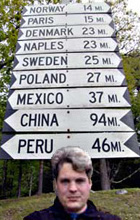Subscribe to the blog 
|
 |
 |
 |
 |
 |
Find a Flight Consider a Consolidator Rent a Car Pick a Railpass Book a Vacation Reserve a Room Get Gear |
|
||||||
|
Getting About (cont'd) << back In England, a diversion will involve far fewer firearms but far more aggravation, as this is their word for "detour," otherwise known as "Getting from Piccadilly Circus to Trafalgar Square via the Cotswolds." Dual Carriageways - A "carriageway" is a highway. When you are tooling down the right-hand side of the "carriageway" and all of a sudden some crazy Brit in his Jaguar comes zipping directly towards you in the same lane, refusing to swerve out of your way, you are engaged in a "carriageway dual." Whichever one of you "chickens out" first has to quickly perform a complex calculation of litres to gallons for petrol and kilometers to miles for distance or has to plow into the guardrail at a speed of 128 quid/centilitre. No, seriously: a "dual carriageway" is just a divided highway, which means if you get on going the wrong way this time you're REALLY in trouble, 'cause you have to drive 8 km to the next exit before you can get to the other side. Pray for light traffic. Give Way - A much more straightforwardly phrased way than "yield" to let you know that you've got to let that long line of lorries go before you at the on-ramp. Hoot - What one is doing when one presses the horn repeatedly and fruitlessly whilst stuck in a "Roundabout." Lay-by - A wide shoulder or small roadside parking lot created especially for tourists to swerve into so they can catch their breath and calm their nerves while they try to figure out how to get onto the other side of the "dual carriageway." The Left Side of the Road - This is what the English call the right side of the road. Or at least, this is the side of the road upon which they inexplicably drive. I mean, I understand the Australians doing it-they've got summer in January and water spirals backwards down their drains, but why the British? My own suspicions, and I have no proof yet, is that they secretly love to watch foreigners, especially Americans, try to kill themselves by going the wrong way up a multilane highway while making frantic and highly amusing gestures and facial expressions the whole time ("That's for dumping our tea in the harbour!" the Brits who are watching yell, chuckling with evil glee as you, in your confusion, begin going in reverse around a roundabout, take out a few lampposts, and forfeit your car rental down payment all at the same time. They are fanatical about tea, those Brits, and they can really hold a grudge). Yes, I know that when YOU get into the car you'll be good and remember that you're supposed to drive on the left side of the road in England. You will probably remember this at about the same time that you figure out why there seems to be a glove compartment on the driver's side of the car and the passenger has the steering wheel. But believe me: despite all your best intentions you will at least once, if not repeatedly, pull out of a parking space and nearly get yourself and your whole family killed by a lorry barreling towards you on what is quite clearly the "wrong" side of the road. At times like these, the proper procedure is to reach over into the passenger's side, grab the steering wheel, and steer onto the sidewalk. Level Crossing - This is just a railroad bridge spanning the road with absolutely nothing funny about it whatsoever (except the mental image of a bunch of tiny carpenter's levels, with their green serum and little air bubbles, inching across the highway like inchworms behind a big Momma carpenter's level). Lorry - A big truck (often of the 18-wheeler or semi variety), the driver of which is going to be just about as amused by your driving directly at him in his lane as you are by gum disease. Pavement - This is the British word for "sidewalk. " Do not drive on it. Save that sort of activity for when you get to Rome or Athens, where it is actively encouraged. In England you might more >> getting
about | food | pubs
& drinking | money & shopping
|

